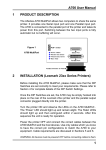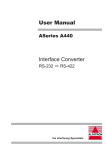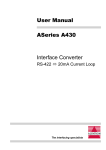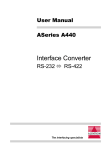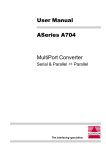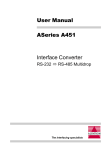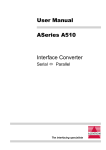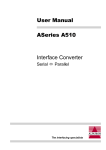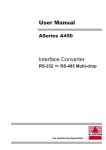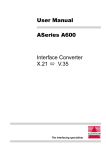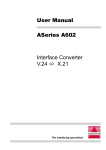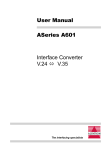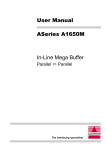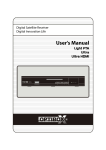Download ASeries A420 User Manual Interface Converter
Transcript
User Manual ASeries A420 Interface Converter RS-232 ó 20mA Current Loop The interfacing specialists A420 User Manual Version 1.10 May 1999 COPYRIGHTS All rights reserved. This document may not, in whole or part, be copied, photocopied, reproduced, translated, or reduced to any electronic medium or machine readable form without the express permission in writing from Alfatron Pty Ltd. Copyright 1999 © Alfatron Pty Ltd DISCLAIMER Alfatron Pty Ltd has made every attempt to ensure that the information contained in this document is accurate and complete. Alfatron Pty Ltd makes no representation or warranties of merchantability or fitness for any particular purpose. Alfatron Pty Ltd reserves the right to make changes to this document at any time, without notice. Therefore, Alfatron Pty Ltd assumes no liability for damages incurred directly or indirectly from errors, omissions or discrepancies with the hardware and the manual. TRADEMARKS All Company and Product names are trademarks of the Company or Manufacturer respectively. WARRANTY Alfatron warrants its products against defects in materials and workmanship for a period of one year from receipt by the customer. All warranty is carried out on a return to depot basis unless an alternative warranty coverage has been arranged. WARRANTY EXCLUSIONS The above warranty shall not apply to defects resulting from improper or inadequate maintenance by the customer, unauthorised modifications or misues, operation outside the environmental specifications for the product, damage due to power surges, lightening strikes or any other phenomenon outside normal operational specifications. Alfatron Pty Ltd ACN: 005 410 819 P.O. Box 4161 Unit 9/36 New St. Ringwood VIC 3134 AUSTRALIA Web Site: www.alfatron.com.au A420 User Manual 1.0 PRODUCT DESCRIPTION The ASeries A420 is an RS-232C to 20mA Current Loop level converter incorporating both Transient Protection and Optical Isolation. The physical layout of the product is shown in the following diagram: 20mA Current Loop Active / Passive Selection Switches Power Jack Serial Port RS-232 Receive Data (Green) Current Loop Terminals Power (Yellow) DCE / DTE Selection 20mA Receive Data (Green) Figure 1.1 - A420 viewed from each angle 1.1 Overview of Features The A420 has a number of features which make it particularly useful in industrial environments and inter-building connections: l The Current Loop interface is particularly suited to environments with poor grounding or grounding problems. l High data transfer rates are possible over long distances, e.g. 19,200bps at a 400 metre length. l Optically isolated data lines provide immunity to ground imbalance, for example between buildings. l High Speed Transient Voltage Suppressors on communication lines. l Units may be ordered as a pre-set, fully isolated pair (2500Vac for 1 minute). l Full duplex point-to-point communication uses only 4 wires, one pair each for receive and transmit data. l Fully configurable Transmitter and Receiver sections - each unit may be either Active or Passive, so the unit may be used in any installation. 1 A420 User Manual 1.2 Isolation Details The electrical isolation provided by the A420 is in three sections as follows: (a) Power Supply Isolation The A420 is supplied with authority approved power adapters which provide the initial mains supply to data link isolation. (b) Isolation by Configuration The 20mA Current Loop Transmitter and Receiver are optically isolated from the RS-232 interface giving the A420 very good Common Mode voltage tolerences. In a 20mA Current Loop installation, typically, one side is configured as an isolated unit while the other is a non-isolated unit. The isolated unit has full breakdown isolation and is typically installed on the sensitive side. (c) Data Link Isolation The line drivers and receivers used in the A420 are specified to withstand 2500Vac for one minute. The design of the A420 allows this specification to be realised on the isolated unit. 1.3 Transient Protection Power surges, or electrical transient voltages, can be induced into cabling by such things as lightning strikes, electric motors, switches and the operation of heavy industrial equipment. The use of long cables also increases the exposure to transient voltages. A transient of the correct magnitude can destroy an unprotected interface converter. It is also possible for certain transients to pass though an unprotected interface converter and cause damage to the equipment which is attached. By using High Speed Transient Voltage Suppressors on its communication lines, the A420 absorbs much of the transient energy on these lines and helps clamp these surge voltages to a safe level. This will ensure that both the A420 and any connected equipment are protected from damage due to transients. The A420 uses a Transient Voltage Suppressor Diode on each of the following: l Current Loop Transmitter and Receiver pairs l RS-232 Transmitter and Receiver lines l unused RS-232 handshake lines are tied to a common voltage rail Each diode has a response time of less than 1ps, power dissipation of 1500 Watts for 1ms and a steady state power dissipation rating of 5 Watts. 2 A420 User Manual Maximum Loop Lengths and Data Rates In the A420 converter the maximum loop length is limited by the current loop cable resistance and the maximum data rate by the RS-232 driver. Typical data rate performance versus distance is shown in the following graph. Please note that the maximum data rate of the A420 is 64kbps and that all loop lengths are measured in one direction only. 1000 10% Distortion Data Rate T A = 25 C ILO O P = 20m A Data Rate - kbps 1.4 100 64 10 Vcc 10V dc 1 10 100 1000 10,000 Loop Length (One Direction) - Metres Figure 1.2 - Typical Data Rate vs. Distance 3 A420 User Manual 2.0 2.1 INSTALLATION l All configuration and cabling to the A420 must be done while NO power is connected to the unit. l No configuration required on the RS-232 Serial port, except for DCE/DTE selection, as the data rate is controlled by the driving device. l On the 20mA Current Loop side the A420 is configured via two slide switches. These switches are located on top of the A420 as shown in Figure 1. For details of the switch configuration please refer to Section 6. l Connect and secure the appropriate cables to the A420. Sections 4 and 5 contain details on cables along with various cable examples. l After all cables have been connected and secured, insert the power plug into the jack socket and turn the power ON. The Yellow Power LED will illuminate and the A420 is now ready for use. LED indicators The Current Loop - Receive Data (RD) LED indicator will flash each time data is being received by the 20mA Current Loop Port. The RS-232 Serial - Receive Data (RD) LED indicator will flash each time data is being received by the RS-232 Serial Port. These LEDs will not operate at any other time. Note: The 20mA Current Loop Standard specifies that 20mA in the loop represents the 'no data idle state' while 0mA represtents the 'data state'. If nothing is connected to the 20mA Receive Data then the loop effectively carries no current, i.e. 'data state', and the Current Loop RD LED will remain ON. 2.2 Using A420s as RS-232 Line Extenders A pair of A420s may be used to achieve connection of RS-232 devices over an extended distance. The A420s are connected via their 20mA Current Loop ports to take advantage of the greater data transfer distances and noise immunity available using the 20mA Current Loop protocol. Section 5 provides a cable example for this type of connection. Please note that the RS-232 devices may only use Software (Xon/Xoff) Flow Control. The A420 does not permit Hardware (DTR/DSR) handshaking. 4 A420 User Manual 3.0 INTERFACE PORT PIN ASSIGNMENTS 3.1 RS-232 Serial Port Pinout The RS-232C Serial Port of the A420 may be configuired as DCE or DTE via a slide switch on the side of the unit as shown in Figure 1. Pin Status Set for DCE Set for DTE 1 2 3 4 5 6 7 8 20 Used Input / Output Output / Input Not used-Pulled High 4K7 Not used-Pulled High 4K7 Not used-Pulled High 4K7 Used Not used-Pulled High 4K7 Not used-Pulled High 4K7 Frame Ground RD TD CTS RTS DTR Signal Ground DCD DSR Frame Ground TD RD RTS CTS DSR Signal Ground DCD DTR Note: Pins 4, 5, 6, 8 and 20 are pulled to the correct levels to allow a PC serial port to operate under most conditions without any additional loopback connections. The Factory Default RS-232 Serial switch setting is DCE as follows: 3.2 20mA Current Loop Port Pinout Transmit Data Minus (-) Transmit Data Plus (+) Receive Data Minus (-) Receive Data Plus (+) 5 A420 User Manual 4.0 CABLE REQUIREMENTS Alfatron Pty Ltd recommends the use of shielded cable with all of its products. Shielding reduces Electro Magnetic Radiation and improves noise immunity. This helps minimise interference to other equipment and will improve the communications reliability. 4.1 Cable Construction The recommended cable construction is as follows: 4.2 l Take the shield (surrounding cable wires) and solder it to the Frame Ground (FG) pin. If FG is not available, use Signal Ground (SG) but in this case always use a separate wire for ground which is connected at both ends. l The shield must be connected at both ends of the cable. Cable Diagrams The cable diagrams in this manual represent the cable shield in the following manner: Figure 4.1 - Example of Shield representation in Cable Diagrams This shows the shield soldered to FG at both ends of the cable and shows the shield running the full length of the cable. Please note that the shield is treated as a totally separate wire. Note: The Current Loop should not be shielded because connecting it to 'Ground' at either side would render the optical isolation redundant. 6 A420 User Manual 5.0 CABLE EXAMPLES 5.1 RS-232 Connection to Other RS-232 Devices Shield A420 Cable End DCE (DB-25 Male) 5.2 FG RD TD CTS RTS DTR SG DCD DSR 1 2 3 4 5 6 7 8 20 FG TD RD RTS CTS DSR SG DCD DTR User Device Cable End Connecting 20mA Current Loop TD A420 Cable End + + RD RD + User Device TD - Cable End TD + RD Note: Sheilding and grounding wires are not recommended for Current Loop cables. 5.3 Using the A420 as an RS-232 Line Extender Two A420s may be connected together to extend the distance at which RS232 data is transmitted. The A420s are connected together via the 20mA Current Loop ports. The following is an example of the cable used to connect A420s together via their 20mA Current Loop ports. 5.4 Cable for connecting A420s together TD A420 Screw Terminal Block TD + + + + RD A420 Screw Terminal Block RD 7 A420 User Manual 6.0 CURRENT LOOP CONFIGURATION Refer to Figure 1.1 for the location of the 20mA Current Loop slide switches. The switch marked TD is for Transmit and the switch marked RD is for Receive. RD TD RD P Active TD 6A Passive TD P Active RD A 6B Passive RD A RD TD RD P Active TD 6C TD Passive TD P Passive RD A 6D Active RD 6.1 TD A Applications requiring Maximum Isolation The A420 may be set up for maximum isolation of 2500VAC for one minute. To do this it is necessary to completely remove the tracks on the Printed Circuit board labelled JMP1, JMP2 and JMP3. These jumpers are located next to the optical isolating components labelled 'HP4100' and 'HP4200' as shown in the following diagram: Note: HP4200 JMP1 JMP2 JMP3 6.2 When this modification is made the A420 can ONLY be configured as 'Passive Transmit' and 'Passive Receive'. HP4100 Factory Default The A420 is shipped from the factory with the slide switches set to 'Active Transmit' and 'Passive Receive' as per item (6A) shown here and above: RD TD Active TD P Passive RD A 6A 8 A420 User Manual 7.0 SPECIFICATIONS Serial Port: Asynchronous RS-232C/V.24 Select as DCE or DTE DB-25 female connector Speed dependant on cable length - maximum 64kbps Current Loop Port: 20mA Current Loop Optically Coupled 20mA Transmitter - HCPL-4100. Optically Coupled 20mA Receiver - HCPL-4200. Screw Terminal Block x 4 (2.5mm diameter). Receive Data and Transmit Data loops may each be configured as either ACTIVE or PASSIVE. Optically isolated for 20mA signal. Isolation in PASSIVE mode only. Transient Protection: Transient Voltage Supression Diodes used as follows: RS-232 - Transmit Data line. - Receive Data Line. - all unused handshake lines are tied to a common voltage rail. 20mA - Transmit Data pair. - Receive Data pair. Surge capacity of 1500 Watts per device at 1ms. Response Time of less than 1ps. Steady state power dissipation rating of 5 Watts. Handshaking: LED Indicators: Power Supply: Dimensions: Weight: Operating Temperature: Stroage Temperature: Software Handshaking (Xon/Xoff) Receive Data Receive Data Power - RS-232 - Current Loop (Green) (Green) (Yellow) 9V (200mA) DC Power Adapter Reverse polarity protection Plug jack - 5.5mm outer/2.5mm inner Outer Negative: 84mm x 58mm x 23mm 160 grams 10° to 35° C 0° to 45° C All specifications subject to change without notice 9 N42 DECLARATION OF CONFORMITY according to the European Commissions EMC Directive 89/336/EEC We, of, Name of Manufacturer: Address of Manufacturer: Australian Company Number: ALFATRON PTY. LTD UNIT 9, 36 NEW ST. RINGWOOD VIC 3134 AUSTRALIA ACN: 005 410 819 declare under sole responsibility that the product: Product Name: ASeries RS-232 to 20mA Current Loop Interface Converter Model Number: A420 to which this declaration relates is in conformity with the following standards: CISPR-22 / EN 55022 class B IEC 801-2 / prEN55024-2 IEC 801-3 / prEN55024-3 IEC 801-4 / prEN55024-4 EMI from Information Technology Equipment (ITE) Electro Static Discharge Immunity Radiated RF Immunity Electrical Fast Transients Immunity












